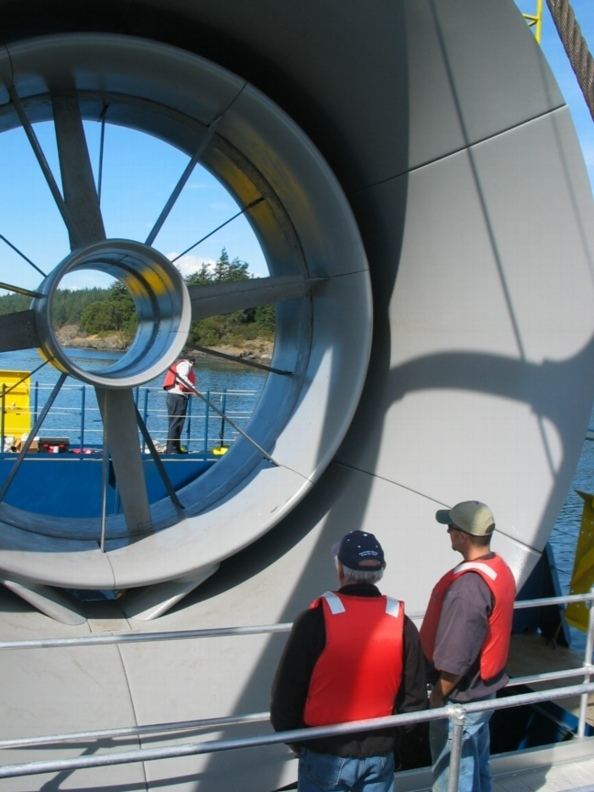 | ||
The shrouded tidal turbine is an emerging tidal stream technology that has a turbine enclosed in a venturi shaped shroud or duct (ventuduct), producing a sub atmosphere of low pressure behind the turbine. The venturi shrouded turbine is not subject to the Betz limit and allows the turbine to operate at higher efficiencies than the turbine alone by increasing the volume of the flow over the turbine. Claimed improvements vary, from 1.15 to 4 times higher power output than the same turbine minus the shroud. The Betz limit of 59.3% conversion efficiency for a turbine in an open flow still applies, but is applied to the much larger shroud cross-section rather than the small turbine cross-section.
Contents
Principles
Considerable commercial interest has been shown in shrouded tidal stream turbines due to the increased power output. They can operate in shallower slower moving water with a smaller turbine at sites where large turbines are restricted. Arrayed across a seaway or in fast flowing rivers, shrouded turbines are cabled to shore for connection to a grid or a community. Alternatively the property of the shroud that produces an accelerated flow velocity across the turbine allows tidal flows formerly too slow for commercial use to be used for energy production.
While the shroud may not be practical in wind, as the next generation of tidal stream turbine design it is gaining more popularity and commercial use. The Tidal Energy Pty Ltd tidal turbine is multidirectional able to face up-stream in any direction and the Lunar Energy turbine bi directional. All tidal stream turbines constantly need to face at the correct angle to the water stream in order to operate. The Tidal Energy Pty Ltd is a unique case with a pivoting base. Lunar Energy use a wide angle diffuser to capture incoming flow that may not be inline with the long axis of the turbine. A shroud can also be built into a tidal fence or barrage increasing the performance of turbines.
Types of shroud
Not all shrouded turbines are the same - the performance of a shrouded turbine varies with the design of the shroud. Not all shrouded turbines have undergone independent scrutiny of claimed performances, as companies closely guard their respective technologies, so quoted performance figures need to be closely scrutinised. Lunar Energy reports a 15%-25% improvement over the same turbine without the shroud. Shrouded turbines do not operate at maximum efficiency when the shroud does not intercept the current flow at the correct angle, which can occur as currents eddy and swirl, resulting in reduced operational efficiency. At lower turbine efficiencies the extra cost of the shroud must be justified, while at higher efficiencies the extra cost of the shroud has less impact on commercial returns. Similarly the added cost of the supporting structure for the shroud has to be balanced against the performance gained. Yawing (pivoting) the shroud and turbine at the correct angle, so it always faces upstream like a wind sock, can increase turbine performance but may need expensive active devices to turn the shroud into the flow. Passive designs can be incorporated, such as floating the shrouded turbine under a pontoon on a swing mooring, or flying the turbine like a kite under water. One design by Tidal Energy Pty Ltd passively yaws the shrouded turbine using a turntable with a peer reviewed claim of 3.84 (384%) increase in efficiency over the same turbine minus the shroud - See Kirke..
